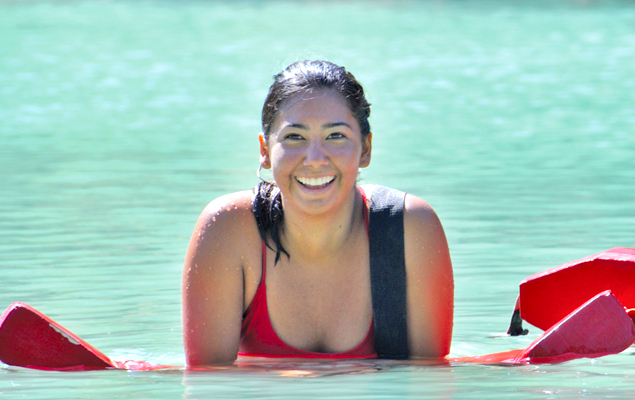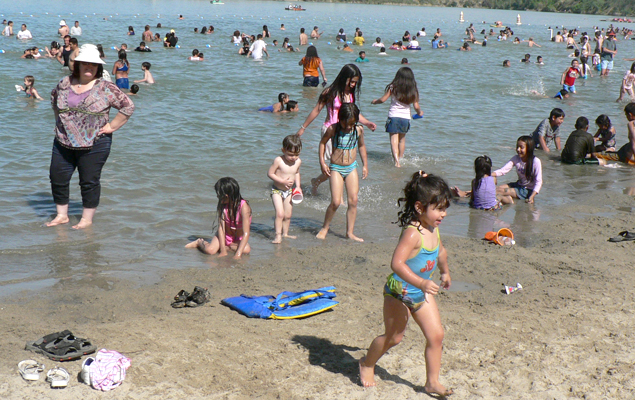
Deaths increase focus on water safety
Following two drowning deaths last month in non-lifeguarded areas at Lake Del Valle Regional Recreation Area in Livermore, the East Bay Regional Park District is again urging visitors to learn how to be water safe when swimming or boating in a regional lake or water facility.
Though the park district provides life-guarded lakes and swim facilities from April to September, tragic incidents can happen anywhere. Nellie Cazares is an Aquatic Assistant who supervises 150 seasonal lifeguards at the district’s lakes, lagoons, and pools. She started as a lifeguard in 2013 and spent a lot of time communicating with Hispanic families in Spanish.
“I would walk onto the beach and hear people speaking Spanish and let them know the rules and answer their questions,” says Cazares. “They are more willing to listen to the rules because I was speaking Spanish.”
One of the most common emergencies is lost children.
“Parents aren’t watching their children,” says Cazares. “We want parents close to their children, paying attention and being in the water with them, and we’ll have fewer lost children.
We want everyone to go home safely at the end of the day.”
“While some 120 lifeguards patrol our swim beaches and lagoons, water safety should be a serious concern for every person entering our parks,” says the Park District’s Aquatics Manager Pete DeQuincy. “Our lifeguards are trained rescuers, not babysitters. We often find unattended youngsters around water. Ultimately, we want to see happy families go home together after a fun day at the park.”
“We want everyone entering our parks to take their own safety and their children’s safety seriously,” says Mona Koh, Community Relations Manager for the park district. “A big part of this shared responsibility is knowing what constitutes safety and putting all the safeguards into practice, whether you are swimming, hiking or biking.”
Cazares explains that the park district has an annual safety program delivered in both Spanish and English. The ¡Vamos a Aprender! program is for children between the ages of seven and fifteen. The program consists of a variety of activities that teach participants about personal safety in the water, rescue and survival techniques, and the aquatic environment. Lifeguards provide the water safety education, which has a strong focus on life-jackets. Participants learn about when they should use life-jackets and how to properly fit them. The program is offered at Del Valle (Livermore) and Shadow Cliffs (Pleasanton) only on the weekends. There are two 45-minute sessions that begin at 11:00 a.m. and 12:00 noon. Sign up's are on a drop-in basis and class sizes are limited. Participants will receive a free life-jacket, wristband, and coloring book to take home.

“By giving them this free life-jacket, we hope that they use it when they come back to our swim facilities or if they are ever in, on, or near the water,” says Cazares.
“Keeping visitors safe is our number one priority at East Bay Regional Parks, whether you’re on land or water,” said Robert Doyle, General Manager. “It’s imperative for people using the Park District’s water facilities and lakes to know how to stay safe when boating or swimming.”
Here are some water safety tips provided by the park district:
• Keep a close eye on your children. Drowning can occur quickly and silently, even in a foot of water.
• DO NOT drink alcohol if you plan on swimming or boating.
• Obey all rules and posted signs.
• Only swim in areas with a lifeguard on duty.
• If you’re not a strong swimmer, take swim lessons. The Park District offers swim lessons throughout the summer.
• Swim with a friend.
• If you’re unsure of your swimming abilities, wear a life jacket. Regional park swim facilities have free loaner life jackets available. Boaters should always wear a life-jacket.
• Children twelve years old and under are not permitted in the swimming area unless accompanied by a responsible, actively-supervising individual sixteen years old or older.
• No lifeguard service is provided at bay beaches.
• Swimming at your own risk is allowed in designated areas and when lifeguards are off duty at some parks.
Cazares offers a last piece of advice for adult swimmers.
“Know your limits if you don’t know how to swim,” she says. “Use a life-jacket - they are free to borrow. Listen to the lifeguards and ask them questions if you don’t know the rules.”
To learn more about safety in the parks, trails and water facilities, visit https://www.ebparks.org/parks/safety/
The East Bay Regional Park District is the largest regional parks system in the nation, comprising 73 parks, 55 miles of shoreline, and 1,250 miles of trails for hiking, biking, horseback riding, and nature learning. The Park District receives more than 25 million visits annually throughout Alameda and Contra Costa counties in the San Francisco Bay Area.
